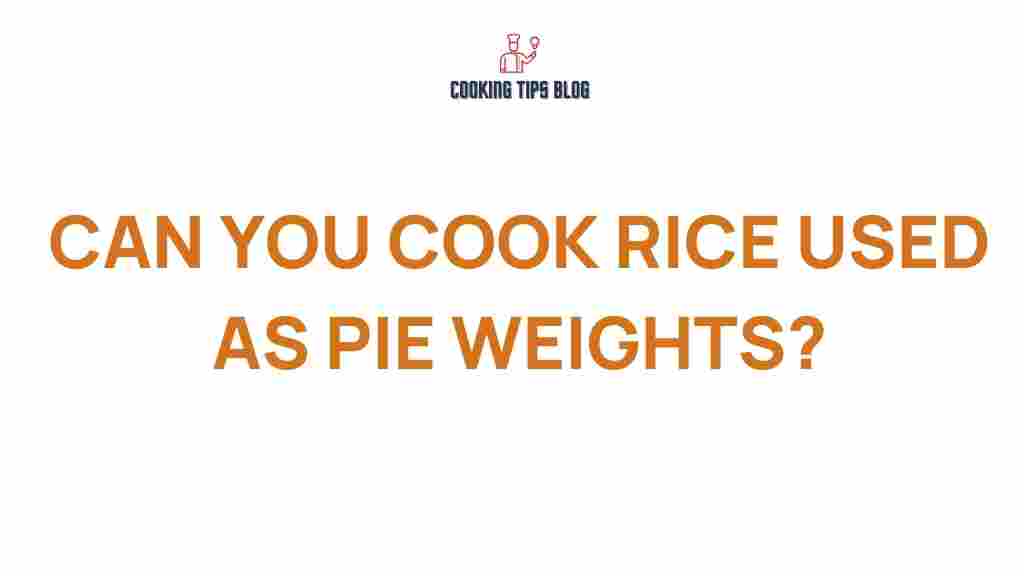The Unexpected Secret: Can You Cook Rice as Pie Weights?
If you’ve ever baked a pie, you know how crucial it is to ensure a perfectly cooked crust. One of the most common methods for achieving this is using pie weights. But have you ever thought about using something as simple as rice as a substitute for these weights? In this article, we will explore the unexpected secret of using rice as pie weights, how to do it effectively, and the benefits of this method. So, let’s dive right into the world of pie baking!
Why Use Pie Weights?
Pie weights are essential for preventing pie crusts from puffing up and shrinking while baking. When you bake a crust without weights, it can rise, leading to an uneven surface and a less than desirable texture. Here are some reasons why using pie weights is beneficial:
- Even Cooking: Pie weights help distribute heat evenly across the crust.
- Prevent Shrinking: They keep the crust in place, preventing it from shrinking away from the pie dish.
- Achieve a Flaky Texture: By keeping the crust weighted down, you’ll create a perfectly flaky texture.
Can You Use Rice as Pie Weights?
The answer is a resounding yes! Rice is an excellent alternative to traditional pie weights. It is readily available, inexpensive, and can be reused multiple times. Using rice as pie weights also offers several advantages:
- Cost-Effective: Rice is typically less expensive than specialized pie weights.
- Easy to Find: Most kitchens already have rice, making it a convenient option.
- Reusable: After using rice as weights, you can still cook it and enjoy a delicious meal!
How to Use Rice as Pie Weights
Using rice as pie weights is simple and straightforward. Follow these steps to ensure success in your pie-making endeavors:
Step 1: Prepare Your Pie Crust
Begin by preparing your pie crust according to your chosen recipe. Roll it out to your desired thickness and place it in your pie dish. Ensure the crust is evenly distributed and pressed into the dish.
Step 2: Poke Holes in the Crust
Before adding the rice, it’s crucial to poke holes in the bottom of the crust using a fork. This technique, known as “docking,” allows steam to escape during baking, preventing the crust from bubbling up.
Step 3: Add the Rice
Place a layer of parchment paper over the crust. This will prevent the rice from sticking directly to the dough. Then, pour the rice evenly over the parchment paper, making sure it covers the entire surface of the crust.
Step 4: Bake the Pie Crust
Preheat your oven according to your pie recipe. Bake the crust with the rice for the recommended time, usually around 15-20 minutes. Keep an eye on it to ensure it doesn’t overcook.
Step 5: Remove the Rice
Once the crust is golden brown, remove it from the oven. Carefully lift the parchment paper with the rice out of the pie crust. Be cautious, as the rice will be hot. Allow the crust to cool slightly before adding your filling.
Tips for Success
To ensure the best results when using rice as pie weights, keep the following tips in mind:
- Use Uncooked Rice: Always use uncooked rice for the best results. Cooked rice will not provide the necessary weight and could become a sticky mess.
- Choose the Right Rice: Long-grain rice or medium-grain rice works best as it provides adequate weight and stability.
- Store After Use: After using the rice, allow it to cool completely before storing it in an airtight container for future use.
Troubleshooting Common Issues
While using rice as pie weights is a straightforward process, you may encounter some issues. Here are some common problems and their solutions:
Problem 1: Crust is Still Puffing Up
If you notice that your crust is still puffing up during baking, try the following:
- Ensure you’ve docked the crust properly with fork holes.
- Use a heavier layer of rice for added weight.
Problem 2: Rice is Sticking to the Crust
If the rice is sticking to your crust after baking, consider these solutions:
- Always use parchment paper to prevent sticking.
- Let the rice cool before removing it to reduce sticking.
Problem 3: Uneven Baking
If your crust is baking unevenly, ensure that:
- Your oven is properly calibrated.
- You rotate the pie halfway through the baking time for even heat distribution.
Final Thoughts
Using rice as pie weights is an innovative and practical solution for achieving a perfectly baked pie crust. With its cost-effectiveness and availability, rice proves to be a handy ingredient in the kitchen. Not only does it provide the necessary weight to keep your crust intact, but it also allows you to enjoy a delicious meal afterward! So, the next time you’re in the kitchen baking a pie, don’t forget this unexpected secret.
For more tips on baking and using kitchen ingredients creatively, check out our baking tips page. If you’re interested in learning about traditional pie weights, you can find more information here.
This article is in the category Tools and created by Cookingtipsblog Team
